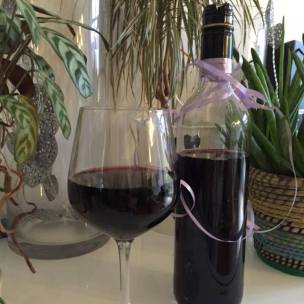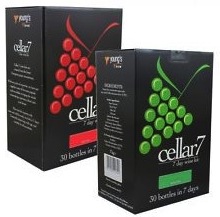
So you are an experienced beer or cider brewer, but you didn’t yet venture into wine making? The transition is easy – you already have the equipment and the know how! And actually, you can make a really excellent bottle of wine for just £3 per bottle.
We get a lot of questions from brewers who are unsure about how to transition into wine, and we did our best to answer these questions in this blog post. Of course, if you have other questions, we are always up for chatting about wine!
How does making wine differ from brewing beer?
Equipment
Just like beer, the fermenting equipment is the same.
Most wine kits come in 23 litre sizes (which make 30 bottles of wine) so your standard 23-litre capacity fermenting kit works perfectly. However, since some wine kits are made in tester sizes of 6 bottles we recommend using a smaller 5 liter fermenting bin or demijohn (to minimise dead air space) for these. Aside from that, all of the rest of your beer testing and siphoning equipment can be used in wine-making too.
Process
Firstly, when choosing wine kits, its good to know that the more grape concentrate the wine kit contains, the better the quality of wine it will produce.
Quality wine kits just need some water added and the yeast in the kit pitched to the must to ferment (some kits also have oak chips and natural clay finings added prior to fermentation). No sugar is needed. The yeast in wine kits is chosen to enhance the variety of the grape used. The fermentation process is similar to beer although in most cases it will take up to 6 weeks – or as little as 1 week for kits with specially developed fast acting yeast. Wine kits also contain the naturally derived additives you need kill off the yeast and clear the wine prior to bottling.
Yeast and Preservatives
Unlike beer where you use residual yeast to carbonate your beer, at the end of primary fermentation you want to stabilise the wine, killing off any residual yeast, and add finings to clear the wine prior to bottling. There is also a process called degassing – removing the CO2 generated in the fermentation through vigorous stirring of the wine to let trapped air bubbles escape. Doing this after stabilising and before fining will help your finings work better and give a clearer wine.
Wine kits always come with recipe-specific quantities of stabiliser, preservatives and finings which are all naturally derived substances and also have the added benefit of having to be added in much smaller quantities than in commercially produced wine.
Following the instructions on the kit will usually produce a wine which will come out at approx. 13% abv, but if you like to customise and experiment with your wine kit you can shorten the fermentation time for a sweeter wine, add flavourings and experiment with different yeasts. Plus, if you need to make a vegan wine you can substitute the wine kit finings (most contain gelatin or isinglass) for bentonite clay-based finings or leave the wine to fine naturally over time.
Bottling
The main difference of course is the bottling – the bottles are bigger. Reuse recycled wine bottles and just buy corks (£3) and a corker (£3.50) to seal your wine bottles correctly so your wine can be stored on it’s side (to keep the cork from drying out, and your wine from oxidising) where it will improve with age. Use screw tops on wine bottles only if you will drink the wine within a couple of months and in that case be sure to store it upright. You can of course buy new wine bottles, and even bottle labels and shrink tops to cover the top of the bottle (heat from a regular hair dryer shrinks them into place), which will give a professional finish as well as further assisting to keep the wine from oxidation.
What’s in a wine kit?
Wine kits contain quality grape juice concentrate – in most cases it is a specific variety of grape juice, and in the best quality kits you can even choose which country of origin your grape comes from. So if you really prefer to make a New Zealand Sauvignon Blanc to a French one – you can do that. The grape juice is also of much higher quality than what you would pick up at your local supermarket. Homebrew wine kits have tiny amounts of sulphites – just enough to keep it fresh – while store-bought grape or fruit juices can have so much preservative they will kill any yeast you add to it, making fermentation almost impossible.
What’s the best wine kit?
All good wine kits come with clear instructions and ingredients and it’s an easy to follow and rewarding process!
If you are looking for something lighter bodied or something quicker to make, you can’t beat the fast fermenting wine kit ranges such as Cellar 7, Cantina and Australian Blend for great value wine kits which produce 30 bottles of wine ready to bottle in a week due to their fast fermenting yeast technology. Great for every day quaffing and parties working out at around a £1 per bottle! For smaller trial bottlings, Beaverdale wine kits and California Connoisseur wine kits come in 30 bottle and 6 bottle sizes.
Brewstore favourites for heavier wines include without doubt the Kenridge Classics and Kenridge Showcase wine kits, which have a great selection of full bodied flavourful and aromatic wines.
For the crafty, there are also country fruit wines such as the Youngs Defini tive wine kits which make 6 bottles of fruit wines such as Elderflower and Blackcherry or Strawberry, and for a lower alcohol fruity wines the Island Mist wine kits ferment out slightly sweeter and lighter and make a great option for adding to ice or soda for summer drinking.
tive wine kits which make 6 bottles of fruit wines such as Elderflower and Blackcherry or Strawberry, and for a lower alcohol fruity wines the Island Mist wine kits ferment out slightly sweeter and lighter and make a great option for adding to ice or soda for summer drinking.
Make your wine a bit extra special by downloading our customized labels right here!
